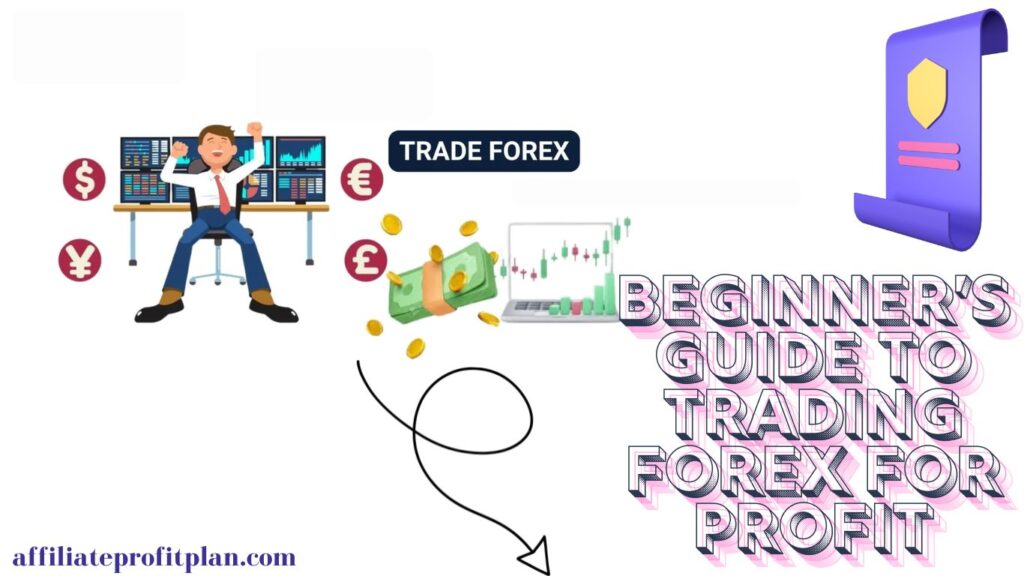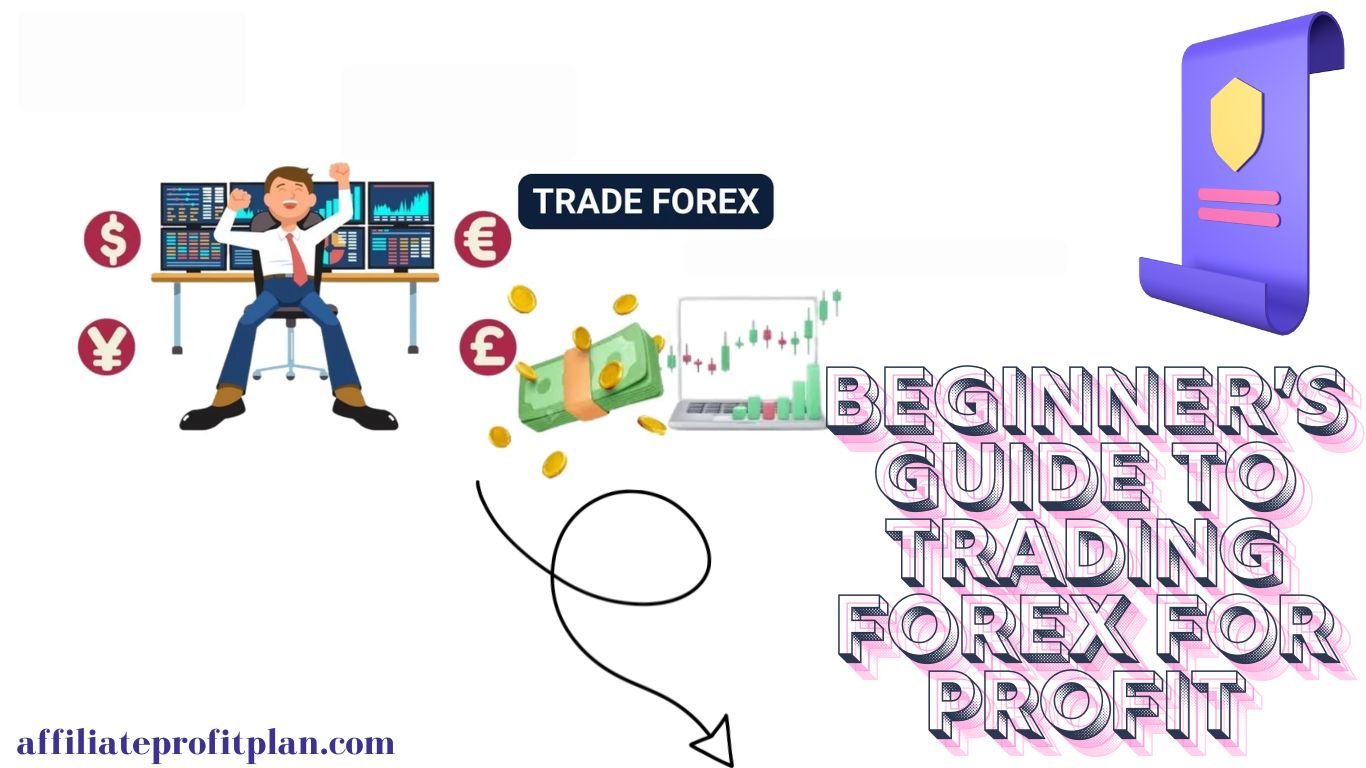Welcome to my article Beginner’s Guide to Trading Forex for Profit. If you’ve ever dreamed of making money from your laptop while sipping coffee in your pajamas, Forex trading might sound like the perfect gig. After all, the idea of buying low, selling high, and watching your bank account grow sounds pretty appealing, right? Well, not so fast—while Forex trading can be profitable, it’s not exactly a magic money machine. Without the right knowledge, strategy, and discipline, you’re more likely to donate your funds to the market than actually make a profit.
Forex (short for “foreign exchange”) is the world’s largest financial market, with over $7.5 trillion traded daily. Unlike the stock market, which has opening and closing hours, Forex runs 24/5, giving traders plenty of opportunities to capitalize on currency movements. But before you start picturing yourself as the next Wolf of Wall Street, let’s be clear—success in Forex isn’t about luck. It’s about understanding the market, managing risk, and sticking to a solid trading plan. In this beginner’s guide, we’ll walk you through the fundamentals of Forex trading, how to get started, and—most importantly—how to trade wisely so you don’t blow your account faster than a weekend shopping spree. Let’s dive in!
Access My Proven Blueprint for $50-$100 Daily Income – Watch This FREE Video Now >>>

Understanding the Basics of Forex Trading
Before you start imagining a life of luxury funded by Forex profits, let’s get one thing straight: trading currencies is not the same as casually exchanging dollars for euros at the airport. The Forex market (short for “foreign exchange”) is the largest and most liquid financial market in the world, with a staggering $7.5 trillion traded daily. That’s more money changing hands in a day than some countries’ entire economies!
At its core, Forex trading is about buying one currency while selling another—always in pairs. For example, if you trade the EUR/USD pair, you’re essentially betting on whether the euro will rise or fall against the U.S. dollar. Think of it as a financial tug-of-war between currencies, where traders profit (or lose) based on how exchange rates shift. Some of the most commonly traded pairs include:
- Major pairs: EUR/USD, GBP/USD, USD/JPY (these are the most liquid and widely traded).
- Minor pairs: EUR/GBP, AUD/JPY (still popular but less traded than the majors).
- Exotic pairs: USD/TRY, EUR/ZAR (these involve currencies from emerging markets and can be more volatile).
Now, before you rush off to open a trading account, you need to understand some key Forex lingo that traders throw around like confetti:
- Pips – The tiny unit of measurement for price movement. If the EUR/USD moves from 1.1000 to 1.1005, that’s a 5-pip change. It may sound small, but when trading large volumes, those pips add up!
- Leverage – This is basically borrowed money from your broker, allowing you to control a bigger position with less capital. A 1:100 leverage means you can trade $10,000 with just $100—but while this can magnify profits, it can also wipe out your account faster than a bad blackjack hand.
- Spread – The difference between the buy (ask) and sell (bid) price. Think of it as the tiny fee you pay your broker for facilitating the trade.
- Lots – The size of your trade. A standard lot is 100,000 units of currency, but beginners often start with mini (10,000 units) or micro (1,000 units) lots to minimize risk.
Unlike the stock market, the Forex market operates 24 hours a day, five days a week, split into different trading sessions—London, New York, Sydney, and Tokyo. This means you can trade whenever suits you (even at 3 AM in your pajamas), but it also means that different sessions have different levels of volatility.
The key takeaway? Forex trading is not gambling. It requires knowledge, strategy, and a deep understanding of market movements. So, before you start clicking “buy” and “sell” at random, let’s move on to how you can actually set up a trading account and get started without blowing your savings in one go.
Setting Up Your Forex Trading Account
Alright, now that you’ve wrapped your head around the basics of Forex trading, it’s time to set up your trading account and take your first step into the world of currency trading. But before you start daydreaming about quitting your job and living off Forex profits, let’s get one thing straight—choosing the right broker and account type can make or break your trading journey.
Step 1: Choosing a Reliable Forex Broker
Not all Forex brokers are created equal. Some are legitimate, regulated firms that provide excellent services, while others… well, let’s just say they’d disappear with your money faster than a magician at a kid’s party. To avoid getting scammed, look for a broker that is:
- Regulated by a reputable financial authority (e.g., FCA, ASIC, CySEC, or the SEC for U.S. traders).
- Offers low spreads and fair trading fees (because every pip counts!).
- Provides a user-friendly trading platform like MetaTrader 4 (MT4), MetaTrader 5 (MT5), or cTrader.
- Has good customer support—because nothing’s worse than having an issue and getting ghosted by your broker.
Pro tip: Avoid brokers that offer “too-good-to-be-true” bonuses or ridiculously high leverage (1:1000 sounds exciting until you realize it can also wipe out your account in seconds).
Step 2: Picking the Right Type of Trading Account
Forex brokers offer different types of accounts, so you need to choose one that fits your experience level and risk tolerance. The most common types include:
- Standard Account – Requires a larger deposit but offers full trading conditions. Best for experienced traders.
- Mini Account – Allows you to trade smaller lot sizes (10,000 units per lot), making it great for beginners.
- Micro Account – Even smaller lot sizes (1,000 units per lot), perfect for those who want to start with minimal risk.
- Demo Account – Highly recommended for beginners! This lets you trade with virtual money, so you can practice strategies without risking real cash.
Step 3: Opening Your Forex Trading Account
Once you’ve chosen your broker and account type, the actual process of opening an account is straightforward:
- Fill out the online registration form with your details (name, email, phone number).
- Verify your identity by uploading a copy of your ID or passport (brokers need this to comply with anti-money laundering regulations).
- Deposit funds using a payment method of your choice (bank transfer, credit/debit card, PayPal, or cryptocurrency, depending on the broker).
- Download your trading platform (MT4, MT5, or the broker’s proprietary platform).
Step 4: Understanding Your Trading Platform
A Forex trading platform is your command center—it’s where you analyze charts, execute trades, and monitor your profits (or, let’s be honest, sometimes losses). The most popular platform, MetaTrader 4 (MT4), offers:
- Live price charts with technical indicators.
- One-click trading to enter and exit trades quickly.
- Customizable trading tools for strategy building.
- Mobile trading so you can trade on the go (because why not place a trade while waiting for your coffee?).
Step 5: Funding Your Account and Getting Ready to Trade
Most brokers allow you to start trading with as little as $50–$200, but keep in mind that trading with a tiny account and high leverage can be a recipe for disaster. Beginners should start small, trade conservatively, and never invest money they can’t afford to lose (Forex isn’t a get-rich-quick scheme, despite what YouTube “gurus” may tell you).
Once your account is funded, you’re ready to move to the next step—learning how to actually trade and develop a strategy that works. Because trust me, randomly clicking “buy” and “sell” is not a trading plan.
Learning Forex Trading Strategies for Beginners
Alright, so you’ve got your Forex account set up, your trading platform ready, and your coffee brewing—now what? Well, before you start throwing trades around like darts at a board, you need a solid trading strategy. Trading without a plan is like gambling in a casino, except instead of free drinks, you get margin calls.
Access My Proven Blueprint for $50-$100 Daily Income – Watch This FREE Video Now >>>
A trading strategy is simply a set of rules that guides your decision-making in the market. It helps you determine when to enter, when to exit, and how to manage risk—so you don’t end up blowing your account on your first day. Let’s go over some beginner-friendly Forex trading strategies that can help you trade smarter, not harder.
1. Trend Following Strategy (AKA “The Trend is Your Friend”)
This is one of the simplest and most effective strategies for beginners. The idea is to trade in the direction of the trend rather than against it. Think of it like surfing—you want to ride the wave, not get crushed by it.
How it works:
- Identify the trend using a moving average (like the 50-day or 200-day moving average).
- If the price is consistently above the moving average, it’s an uptrend (look for buying opportunities).
- If the price is consistently below the moving average, it’s a downtrend (look for selling opportunities).
Why it works:
- You’re trading with the market’s momentum, not against it.
- It helps you avoid counter-trend trades that can wipe out beginners quickly.
Pro tip: Use trendlines and indicators like the Relative Strength Index (RSI) to confirm trends before jumping in.
2. Support and Resistance Strategy (Buying Low, Selling High—The Smart Way)
Support and resistance levels are like the floor and ceiling of the market—prices tend to bounce off these key levels. Identifying these zones can help you make smarter trades.
How it works:
- Support: A price level where an asset tends to stop falling and bounce back up.
- Resistance: A price level where an asset tends to stop rising and pull back down.
- When the price approaches a support level, consider buying.
- When the price approaches a resistance level, consider selling.
Why it works:
- These levels represent areas where traders historically place buy or sell orders.
- Markets often react predictably at these levels, making them great entry and exit points.
Pro tip: Use candlestick patterns (like the Doji or Hammer) for confirmation before placing a trade.
3. Breakout Strategy (Catching Big Moves Early)
This strategy focuses on trading when the price breaks out of a key level, leading to a strong trend movement. Think of it like opening a shaken soda can—the price is building pressure, and when it finally bursts, it moves FAST.
How it works:
- Identify key support and resistance levels (or consolidation zones).
- Wait for the price to break through these levels with high momentum.
- Enter a trade in the direction of the breakout (buy if it breaks resistance, sell if it breaks support).
Why it works:
- Breakouts often lead to strong price movements.
- You can catch trends right at the beginning instead of chasing them.
Pro tip: Use the Average True Range (ATR) indicator to measure volatility—higher volatility often means stronger breakouts.
4. Scalping Strategy (For Those Who Like Fast-Paced Action)
Scalping is all about making quick trades—often within minutes or even seconds—to capture small price movements. If you have the patience of a caffeinated squirrel, this might be for you.
How it works:
- Open and close multiple trades in a short time frame (1-minute or 5-minute charts).
- Look for tiny price movements using indicators like the Bollinger Bands or Moving Averages.
- Take small, consistent profits and avoid holding trades too long.
Why it works:
- You don’t need to predict long-term trends—just small price fluctuations.
- Can be profitable in both trending and ranging markets.
Pro tip: Scalping requires low spreads and fast execution, so make sure your broker offers a good trading platform with minimal slippage.
5. Risk Management: The Key to Surviving Forex Trading
No matter which strategy you choose, the most important thing in Forex trading is risk management. Even the best traders lose trades, but what separates winners from losers is how well they manage losses.
Here’s how to not blow up your account in a week:
- Use stop-loss orders – This automatically closes your trade if the market moves against you too much.
- Never risk more than 1-2% of your account per trade – If you have $1,000, don’t risk more than $10–$20 per trade.
- Don’t revenge trade – If you lose a trade, don’t jump back in out of frustration (that’s how accounts disappear).
- Stay emotionally disciplined – Forex isn’t about getting rich overnight; it’s about consistency over time.
Final Thoughts
Forex trading strategies aren’t one-size-fits-all. Some traders prefer long-term trend following, while others love the adrenaline rush of scalping. The key is to experiment with different strategies, use a demo account, and find what works for you.
But remember—a strategy is only as good as the trader using it. Stick to your rules, manage your risk, and don’t let emotions take over. Forex trading can be profitable, but it’s a marathon, not a sprint. Now, go sharpen your skills and trade wisely!
Practicing with a Demo Account Before Trading Live
Alright, so you’re pumped to start trading Forex and picturing yourself as the next market wizard. But before you dive headfirst into the financial deep end, let’s talk about demo accounts—your Forex training wheels that can keep you from face-planting right out of the gate.
A demo account is a risk-free trading environment where you trade with virtual money instead of real cash. It’s like playing a video game but with real market conditions—no actual money at stake, but all the lessons of live trading. If you lose, no harm done; if you win, well, it’s still fake money, but at least your ego gets a boost.
Why Every Beginner Needs a Demo Account
Think of it this way: would you try to fly a plane without spending time in a flight simulator first? Probably not (unless you’re aiming for a very short and dramatic career). Trading is no different. A demo account helps you:
- Understand how the Forex market works – You get hands-on experience with real-time price movements, currency pairs, and order execution.
- Learn your trading platform – Every broker’s platform has its quirks, and pressing the wrong button could mean accidentally opening a massive trade when you just meant to check the charts.
- Test different trading strategies – Remember all those trading strategies we talked about? A demo account lets you test them without risking real money.
- Get a feel for market psychology – You’ll start recognizing patterns, trends, and price movements without the emotional stress of losing actual cash.
How to Make the Most of Your Demo Trading
Now, just because it’s “fake money” doesn’t mean you should go on a trading spree like a kid in a virtual candy store. Treat your demo account as seriously as you would a real account. Here’s how to practice properly:
1. Trade With a Realistic Balance
Many demo accounts come with $50,000 or even $100,000 in virtual funds. That’s great, but unless you plan on depositing that much in real life, it’s not helpful. Instead, adjust the balance to match what you’d actually start with—whether that’s $500, $1,000, or $5,000.
Why? Because trading with an unrealistically high balance might give you a false sense of security. You’ll take bigger risks, thinking losses don’t matter. But when you switch to a live account, those risks could wipe you out fast.
2. Follow Proper Risk Management
Speaking of risk, use stop-loss orders, risk only 1-2% of your balance per trade, and avoid overleveraging—even in a demo account. If you get reckless in practice, you’ll be reckless in real trading. And in live trading, reckless = broke.
3. Trade Like It’s Real Money
If you treat your demo account like a casino, you’ll learn nothing useful. Instead:
- Stick to your strategy – Follow the trading plan you intend to use in a real account.
- Keep a trading journal – Record your trades, what went right, what went wrong, and what you learned.
- Avoid emotional trading – Just because it’s virtual money doesn’t mean you should enter random trades for fun.
The goal is to build discipline and develop good trading habits before going live.
How Long Should You Trade on a Demo Account?
There’s no magic number for how long you should practice with a demo account, but here’s a good rule of thumb:
- If you’re consistently profitable for at least 2–3 months, you may be ready to switch to live trading.
- If you’re still making impulsive trades, blowing your account, or struggling to follow a strategy, keep practicing.
Think of it as earning your driver’s license—you wouldn’t hit the highway without passing a few driving tests first, right?
Switching to a Live Account: The Right Way
Once you feel confident, don’t jump straight into live trading with a huge deposit. Instead, ease into it with a small amount—maybe $100 or $200—and trade micro-lots. Even a small amount of real money changes the game because suddenly, emotions kick in:
- Winning feels amazing.
- Losing stings—A LOT.
A gradual transition from demo to live helps you adjust to the emotional side of trading without the risk of losing big.
Final Thoughts
A demo account is your best friend as a beginner trader. It lets you make mistakes without losing a dime and helps you refine your skills before going live. But remember—treat it like real money. If you take it seriously, you’ll be way better prepared when it’s time to trade for real.
And when that time comes? Trade smart, trade small, and most importantly—don’t let your emotions run the show. Happy trading!
Tips for Managing Risk and Maximizing Profits
Ah, the dream of every Forex trader: minimizing losses while raking in the profits. If only it were as easy as clicking “Buy” and watching your account balance skyrocket. Unfortunately, Forex trading isn’t a magical ATM—it’s more like a roller coaster that can either make you rich or make you queasy (or both).
The key to long-term success? Risk management. Trading without a risk management plan is like driving without brakes—you might enjoy the speed at first, but sooner or later, you’re going to crash. So, let’s dive into some battle-tested tips to protect your money while maximizing your gains.
1. Never Risk More Than You Can Afford to Lose
This sounds obvious, but you’d be surprised how many traders go all-in on a single trade like they’re betting their life savings on a horse named “Lucky Pip.” Spoiler alert: it usually doesn’t end well.
A good rule of thumb? Never risk more than 1-2% of your trading capital on a single trade. If you have $1,000 in your account, that means risking no more than $10-$20 per trade. This way, even if you hit a rough patch (and you will), you’ll still have plenty of capital left to trade another day.
2. Use Stop-Loss Orders—ALWAYS
A stop-loss order is a trader’s best friend (next to caffeine and a solid Wi-Fi connection). It’s an automatic exit that limits your losses when a trade goes against you.
Example: Let’s say you buy EUR/USD at 1.1000, expecting it to go up. If you set a stop-loss at 1.0950, your trade will automatically close if the price drops to that level, preventing further losses.
The worst thing you can do? Trade without a stop-loss and “hope” the market turns around. The market does not care about your hopes—it will steamroll your account if you’re not careful.
3. Take-Profit Orders: Lock In Those Wins
A take-profit order works like a stop-loss but in reverse—it automatically closes your trade when it hits a profit target.
Why is this important? Because greed is a trader’s worst enemy.
You might think, “I’ll just wait a little longer for more profit,” but the market can turn against you in seconds. A take-profit ensures you walk away with your gains before the market changes its mind.
A good strategy? Use a risk-to-reward ratio of at least 1:2. If you risk 20 pips, aim for at least 40 pips in profit. This way, even if you win only half of your trades, you’ll still be ahead.
4. Don’t Overleverage—It’s a Double-Edged Sword
Leverage is one of Forex’s biggest attractions. It allows you to control a large trade with a small amount of money. Sounds great, right? Well, it is—until it isn’t.
Example:
- With 50:1 leverage, a $100 deposit lets you control $5,000 in the market.
- With 100:1 leverage, that same $100 lets you control $10,000.
The upside? Bigger potential profits.
The downside? Bigger potential losses.
If the trade moves against you, leverage can wipe out your entire account in minutes. New traders should stick to low leverage (10:1 or lower) until they gain experience.
5. Control Your Emotions—Trade with Logic, Not Fear or Greed
The Forex market is a 24/5 emotional rollercoaster. One moment, you’re celebrating a win; the next, you’re questioning your life choices. The key? Don’t let emotions control your trading.
Common emotional traps:
- Revenge Trading – You lose a trade and immediately jump back in to “win it back.” Big mistake.
- FOMO (Fear of Missing Out) – You see a big price move and jump in too late, only to watch it reverse.
- Overtrading – You take too many trades out of excitement or boredom, instead of sticking to your strategy.
Solution? Have a trading plan and stick to it. If a trade doesn’t meet your criteria, walk away. The market isn’t going anywhere.
6. Keep a Trading Journal—Your Personal “Cheat Sheet” for Improvement
Want to become a better trader, faster? Keep a trading journal.
Write down every trade, including:
- Why you entered (your reasoning and strategy)
- Entry & exit prices
- Profit/loss
- What you learned
Reviewing your journal helps you spot mistakes, improve strategies, and stay accountable. Plus, it’s a great way to track your progress.
7. Stay Updated on Market News—Because Surprises Are for Birthdays, Not Trading
Economic news can send currency prices flying—sometimes in the wrong direction. If you don’t pay attention to news events, you’re basically trading blindfolded.
Keep an eye on:
- Interest rate decisions (by the Federal Reserve, ECB, etc.)
- Employment reports (like U.S. Non-Farm Payrolls)
- Inflation data
- Geopolitical events (wars, trade deals, etc.)
A sudden interest rate hike or political crisis can wreck your trade in seconds. Check an economic calendar before trading to avoid getting caught in market chaos.
8. The Golden Rule: If It Looks Too Good to Be True, It Probably Is
Be wary of:
🚩 “Guaranteed profit” Forex signals – No strategy wins 100% of the time.
🚩 Scam brokers – Always choose a regulated broker.
🚩 Get-rich-quick schemes – Forex trading requires skill, patience, and practice—not magic.
Final Thoughts
Managing risk isn’t just about avoiding losses—it’s about staying in the game long enough to become profitable. Protect your capital, follow a solid strategy, and trade smart.
Because in Forex, survival = success. Stick to these tips, and you’ll give yourself the best shot at long-term profitability.
Happy trading!
Conclusion: Mastering Forex—One Trade at a Time
If you’ve made it this far, congratulations! You now know more about Forex trading than the average person who still thinks “pip” is just a cute way to say “pip-squeak.” But let’s be real—reading about Forex is one thing; actually trading is another.
Access My Proven Blueprint for $50-$100 Daily Income – Watch This FREE Video Now >>>
Forex isn’t some overnight get-rich scheme. It’s a skill that takes time, patience, and a solid risk management plan. Some days, you’ll feel like a financial genius; other days, you’ll wonder why you didn’t just stick to a nice, safe savings account. But the traders who succeed are the ones who learn from mistakes, refine their strategies, and never stop improving.
Remember these key takeaways:
✅ Understand the basics—Know your pips, pairs, and price movements.
✅ Set up your account properly—Choose a legit broker and start with a demo account.
✅ Learn solid strategies—Forget gambling; trade with a plan.
✅ Practice before going live—Demo trading saves you from expensive mistakes.
✅ Manage risk wisely—A small loss today is better than blowing up your account tomorrow.
At the end of the day, Forex is a marathon, not a sprint. Keep learning, stay disciplined, and who knows? With enough practice, you might just go from Forex beginner to full-time trader. And if nothing else, at least you’ll finally understand what all those charts and candlesticks mean!
Happy trading, and may your pips be ever in your favor!
Thanks a lot for reading my article on “Beginner’s Guide to Trading Forex for Profit” till the end. Hope you’ve helped. See you with another article.










